| 1 | Sumatran short-tailed python |
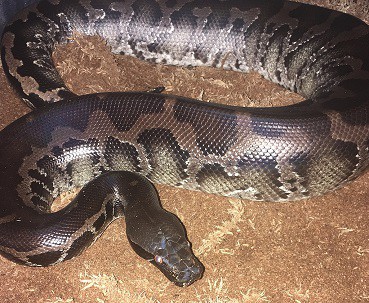
A species of western Sumatra, Indonesia, which averages at 1.5 metres and is thick like a tree trunk. Sumatran short-tailed pythons have black and brown patterns, which have evolved to mimic the muddy swamp shores they lie on. This allows them to fulfil their chosen lifestyle: an ambush predator which moves only every few days, staying still like a fleshy serpent statue otherwise. Sumatran short-tailed pythons mainly eat mammals, and to acquire them they perform a rapid lunge, which contrasts horrifically against their usual sluggishness. After swallowing, it’s back to perfect stillness again, like nothing ever happened.
It’s a basic cost benefit analysis for this species, where the answer lies clearly with barely moving. If they decided to be an active forager, then short-tailed pythons aren’t fast enough to compete with an oriental ratsnake, which are not only fast, but nimble tree climbers. A short-tailed python would cause branches to snap with its crushing weight.
This python is so large that any prey it crept up on would easily see it coming. If their eyesight was poor, they’d still see the vague outline of a huge slithering mass. So the Sumatran short-tailed python’s fate was sealed: they would become an ambush predator, and they’ve only grown lazier and more powerful since then.
| 2 | Emerald tree boa |
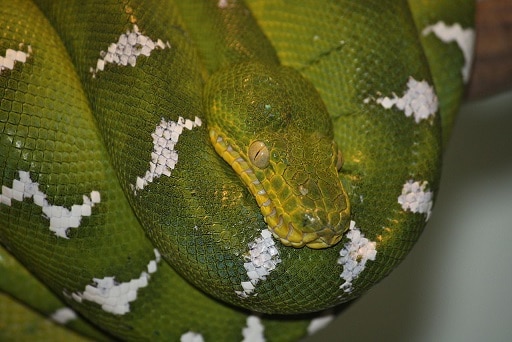
A 2 metre species of the Amazon rainforest, recognisable by its green scales overlaid with white. Emerald tree boas are non-venomous and can spend an entire week without moving. This is a rainforest snake which shuns speed and relies on immense camouflage and patience.
Corallus caninus lives in a world of cackling monkeys, squawking birds, and sipos slithering past eagerly in pursuit of a meal. They live in a hub of activity, but this has no effect on them. The emerald tree boa sticks to its game plan, ignoring outside distractions and staying the course.
The emerald tree boa moves mainly in two circumstances: 1) lunging at an unsuspecting mammal, or 2) shifting to a new ambush position. If a human walks past, they probably won’t react, except maybe flecking their tongue. Because of their laziness, the emerald tree boa is a safe snake to observe and photograph from a distance. Touching them is most unwise, as suddenly, they won’t be so lazy anymore. Corallus caninus was once thought to eat birds, but actually eats mainly mammals.
| 3 | Ussuri pitviper |
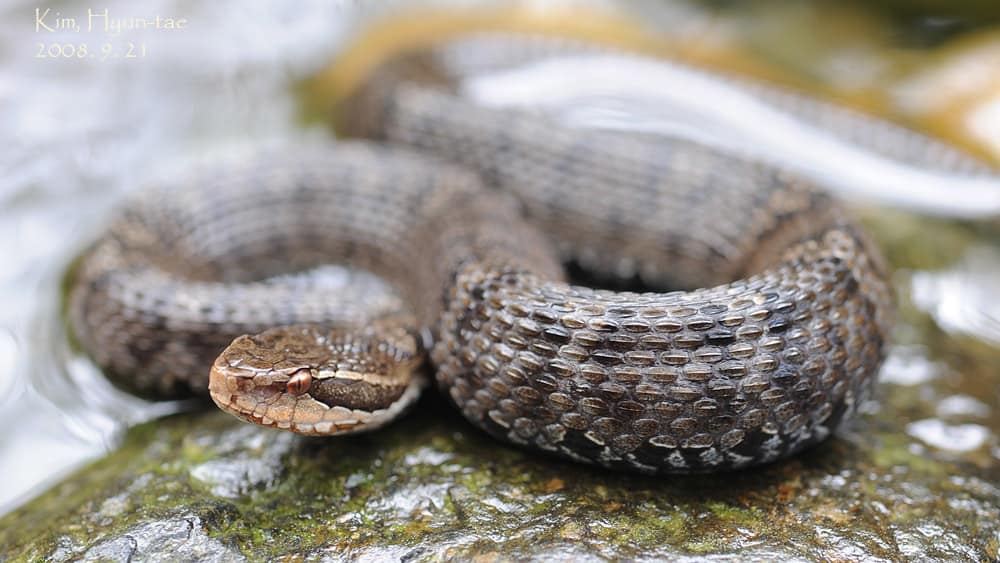
The Ussuri pitviper is one of South Korea’s most dangerous snakes. They cause dozens of bites per year, and are one of the main species used to develop the country’s viperid antivenom, along with Central Asian pitvipers. The venom is dangerously cytotoxic, unleashing necrosis, but the redeeming factor is how lazy they are. Ussuri pitvipers slither slowly, and move short distances per day, in their forested valley habitats.
A 2015 study provided evidence, finding that 7 Ussuri pitvipers moved just 3-32 metres from their original position over 300 days. Ussuri pitvipers can be spotted prowling along river shores, but it’s more of a patient patrol, rather than the twitchy, caffeinated dash of an oriental ratsnake.
Ussuri pitvipers tend to stay within a small home range of just 60 metres. It’s common to spot a menacing viper staring at you with its vertical pupils, and return 10 days later to find it in the exact same place. Though they’ll never charge you down, their lazy ways make this South Korean snake dangerous in other ways: it’s easy to step on one while walking your dog. Their camouflaging colours add to this problem.
| 4 | Large-eyed pitviper |
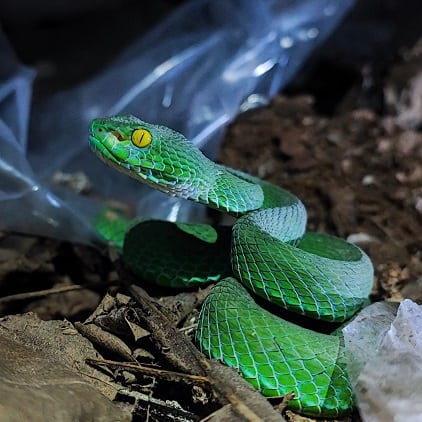
This Thai snake is a common resident of people’s gardens, hissing and lunging when all they want to do is drop leaves on their compost pile. Large-eyed pitvipers are extremely common in Thailand, and average at 60cm. They have a powerful cytotoxic venom, which can cause severe necrosis in a bite lasting less than a second. This species bites dozens of people annually, but whether it’s a blessing or a curse, they’re an extremely lazy snake.
A study on large-eyed pitvipers found an average daily movement of just 3.2 metres. This was conducted in the Sakaerat Biosphere Reserve of northeast Thailand for over 2 months. This pitviper has strong home territories, sticking to their own corner of the forest and overlapping minimally.
Vipers aren’t hyperactive in general, but the white-lipped pitviper is far more stationary than most. As their green camouflage is so effective in bushes, it causes many oblivious Thai people to miss them. On the other hand, they’re not maniacs which slither into people’s kitchens and fight a guy with a spoon like the monocled cobra. Large-eyed pitvipers are especially common in Bangkok itself, along with white-lipped pitvipers.
| 5 | South American bushmaster |
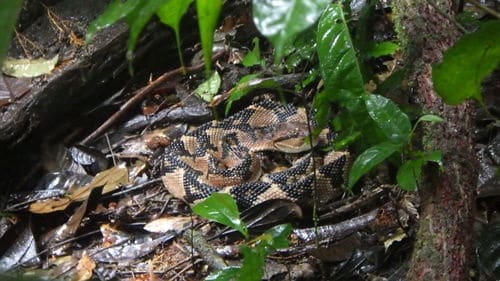
A 3.5 metre snake found in the forests of South America. Lachesis muta is non-venomous, although their fangs have the potential to cause pain. They rarely encounter humans, mainly because they’re a sluggish snake which can move just a few metres per week. Instead of stalking prey, they carefully select an ambush spot, often behind a bush, and wait there for days.
Virtually no part of its body moves. The South American bushmaster might fleck its tongue occasionally. It might rearrange its head in its coils, and its subtly breathing body is a giveaway that this isn’t in fact a weirdly fleshy log. But most mice scampering past are too distracted to notice this. They’re too wrapped up in their own world, and it’s normally too late when a giant serpent lunges at them from nowhere.
South American bushmasters are exceedingly patient, and it takes them days to tire of a location, concluding that it’s clearly fruitless. They’re not infallible though, as rats commonly duck beneath their coils and make a heroic bid for freedom. South American bushmasters produce an enormous yield of venom, up to 500mg, so watch your step.
| 6 | Dog-faced watersnake |

A snake of muddy coastlines in India. Dog-faced watersnakes are a semi-aquatic species measuring 80 centimetres, which has no venom and exclusively eats fish. They’re an abundant species, with dozens appearing in one muddy tidal flat, and each snake commonly has its own small pool to live in.
Unlike most of our list, the dog-faced watersnake isn’t a strict ambush predator. Instead, their tidal pools are so rich with fish that they barely need to move. These pools are constantly replenished, and many dog-faced watersnakes can open their mouths, swim through a school of fish, and catch a meal with minimal effort. Another hunting strategy is to poke their heads into muddy pools and grab fish as they swim past.
Studies show that they move minimal distances, with occasional migrations of up to 500 metres, often to find mates. In one study, 20% of dog-faced watersnakes were less than 10 metres from their pools 8 months after they was first observed.
Dog-faced watersnakes live life on easy mode. This has allowed them to spread to every corner of the Indian coastline, with their territory ending in central Thailand.
| 7 | Eastern twig snake |
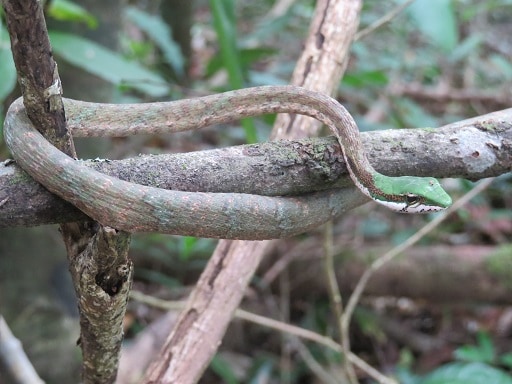
This snake’s very survival depends on not moving all day. The eastern twig snake (Thelotornis mossambicanus) has one great advantage over other snakes – a close resemblance to a tree branch.
Its brown body is the exact colour of tree bark, while its head switches suddenly to green, to blend with leaves. Birds will fly overhead, annoyed at their lack of hunting success, while chattering tourists will walk past and not see a thing. If the eastern twig snake moves, then its camouflage is ruined, and that’s why this is one of southern Africa’s most stationary snakes. They cling to branches virtually all day, usually on lower bushes rather than high in the canopies.
Thelotornis mossambicanus is an ambush snake which preys mainly on lizards, continually scanning the ground for them. They mainly embark on long journeys when they catch a smell of female pheromones, and decides to seek out the source. This is secretly a highly venomous snake, one of the less researched dangerous snakes worldwide. If you do prove sharp-eyed enough to see through its disguise, then simply nod, walk off and leave it to its incredibly lazy business.
| 8 | Broad-headed snake |
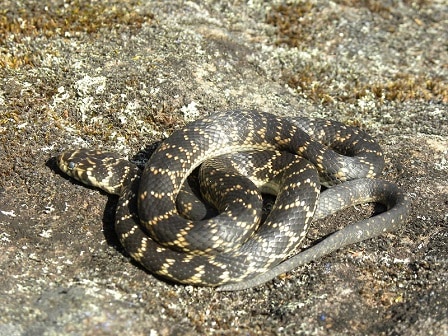
One of Australia’s most endangered serpents. Broad-headed snakes are a moderately venomous species measuring 60cm, which can go days without moving. They’re found exclusively in open ridges within national parks, far from humanity, with an abundance of loose bushrock, usually in a tree clearing.
Hoplocephalus bungaroides has adapted its hunting to these environments, hiding in dark cracks formed by erosion and natural weathering. They patiently wait for lizards to appear on the rocks, then perform a sudden lunge when they sense them approach. Quite simply, moving around all day is contrary to the broad-headed snake’s every instinct, against everything they’ve ever learnt. Hoplocephalus bungaroides’s success rate is based on choosing the optimal ambush site, usually one adjacent to an open, sunny ridge. Then they can wait in their dark cracks for days, and wait for the inevitable lizard hoping to warm its body.
Broad-headed snakes perform a migration some years, where they move to a hilly forest adjacent to their ridge. Then they resume their immobile ambush strategies, finding more forested rock piles to lurk in. The main reason broad-headed snakes are endangered is people poaching bushrock for ornamental garden displays.
| 9 | Pygmy rattlesnake |
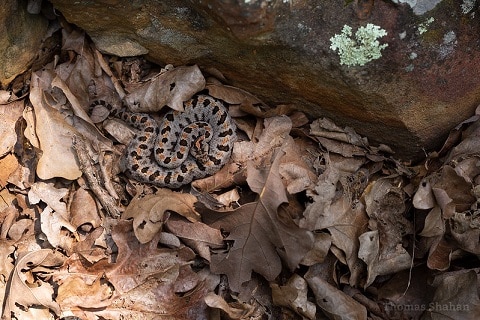
Pygmy rattlesnakes live in Florida and Georgia, and are the shortest member of the family, at an average of 38-58cm. Perhaps wisely, they’ve decided not to enter the battle fray, and instead lurk in forests as an ambush hunter.
Pygmy rattlesnakes move tiny distances per day. One study released individuals implanted with radio trackers. This technology proved unnecessary, as 19.5 months post release, several males were just 9 metres from their original position. Pygmy rattlesnakes primarily eat mammals, and their favourite strategy is to position themselves directly behind logs. When a mammal scampers along the top, the rattlesnake rapidly snatches them off. They also lurk in tall grass, on the very borders, adjacent to open spaces favoured by mammals.
Pygmy rattlesnakes have one of the cosiest habitats of any rattlesnake, warm forests with plenty of fallen logs. Yet it’s also one of the laziest species. Meanwhile, the most energetic rattlesnake of all has the most extreme habitats – the sidewinder, which lives in true deserts, including those with rolling sand dunes. Sidewinders regularly move over 200 metres per day.
| 10 | Green mamba |
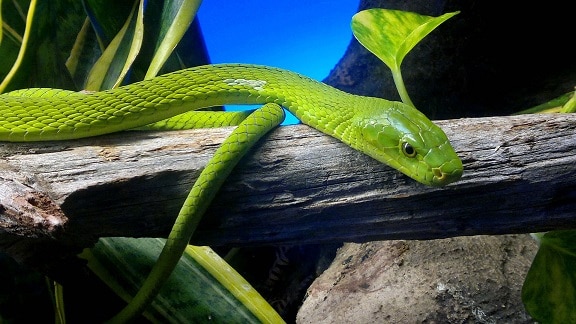
The black mamba’s closest relative, found in coastal forests of southeast Africa. Green mambas have a few differences: 1) they’re far greener, 2) they mainly live in trees, and 3) they move far fewer metres per day.
Black mambas are a manic species, exploring savannah and rocky hills all day, but green mambas are more relaxed, and would rather drape themselves over a tree branch all day. This is an ambush snake which preys on a mixture of birds and mammals, disabling them with a neurotoxic venom. In 1994, a study tracked green mambas in coastal forests of Kenya, 5km from the Indian ocean. After 27 days, it found that on most days, green mambas moved less than 5 metres.
The green mambas tended to perform small movements within one tree, dropping to lower branches, then ascending again, in careful rather than frantic movements. Every few days, they moved through the canopy to find a new root position. While mainly a tree snake, green mambas aren’t allergic to the ground, and can also be found draped around railings and snake warning signs. As a relatively stationary snake, bites are mercifully rare from the green mamba.
